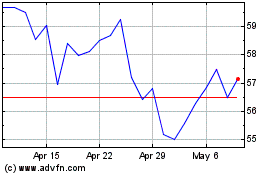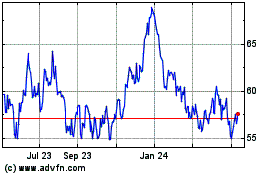By Robb M.Stewart
MELBOURNE, Australia -- Activist investor Elliott Management
Corp. has mounted pressure on BHP Billiton Ltd. to defend not only
its corporate structure, but also whether it takes advantage of a
peculiarity of Australian investing: franking credits.
Elliott, an aggressive investor that manages almost $33 billion,
has been trying for months to convince BHP executives of the
shareholder value that could be unlocked by spinning off its U.S.
petroleum assets and collapsing a dual Australia-U.K. structure. It
has now taken the idea public to try to convince other investors,
though BHP is fighting back.
Investors in Australia welcomed the debate stirred by the
proposal, particularly if it encourages greater returns from BHP,
although some questioned the lift in value projected by Elliott and
how easy it would be to achieve.
Much of the value that Elliott expects comes through unifying
BHP as a single entity with its headquarters and tax residency in
Australia, then leveraging local tax benefits -- the franking
credits -- to buy back shares at a discount. In its letter, Elliott
argued the dual-listed structure had "far outlived its original
utility" and prevents the company from passing on the Australian
tax credits to all shareholders.
The dual-listing structure was used to ease the way for the 2001
tie-up of Australia's BHP Ltd. and London-listed Billiton PLC
without either acquiring the other in a legal sense.
BHP says the proposal makes no mention of hefty costs that would
outweigh the benefits of concentrating on a single structure.
The plan could also run up against the government. A spokeswoman
for the treasurer said any significant changes to BHP would need to
be consistent with Australia's national-interest test and would be
carefully considered.
In 2015, the Treasury recommended the merger of BHP and Billiton
but on the conditions that BHP Ltd. remain the ultimate holding
company and retain an Australian listing, the global headquarters
be in Australia, and the chief executive and chief financial
officer have their principal residence in Australia.
Australia and New Zealand are the last two countries with a
franking, or imputation, system after countries including the U.K.,
Germany, Singapore and Malaysia abandoned their systems over the
past 15 or so years.
Franking was introduced in 1987 to stop dividends from being
taxed twice. The credits allow companies to pass along as a benefit
taxes paid on Australian operations, reducing or eliminating the
tax investors pay on dividends.
By last year, BHP had amassed a balance of franking credits
worth $9.7 billion, or about 10% of its total market value.
Unifying BHP as an Australian tax resident would allow it to buy
its Australian shares at a discount and release far more franking
credits, according to Elliott.
Elliott argues for using the credits when buying back Australian
shares at a discount, making use of an Australian Taxation Office
allowance to buy back shares off market at an up to 14% discount.
The hedge fund estimated a new structure would enable BHP to return
about $33 billion to shareholders through off-market buybacks over
five years, through mid-2022, lifting earnings per share by about a
third.
Shareholders in Australia would welcome a faster release of
franking credits but acknowledge that BHP has reviewed its
structure and failed to find a solution. Some noted that nothing
prevents BHP from buying back its U.K. shares whenever they trade
at a discount to the Sydney shares, which would offer a similar
boost to earnings per share.
Some also argued that the nature of BHP's business raises
questions about big buybacks. Big mining companies haven't had the
balance-sheet strength to consider buying back shares until a
recent recovery in prices for iron ore, coal and other commodities
and after cutting costs and debt.
In a presentation to investors Wednesday, BHP said that unifying
its structure would cost $1.3 billion in taxes, plus $3 billion in
lost value. In addition, as a single entity, some $7.3 billion in
franking credits would have been paid since 2001 to investors not
holding the Australian shares who mainly couldn't use them. BHP has
taken advantage of the existing structure previously to maintain
equal dividends to both sides of the company, using its franking
credits to fund the U.K. PLC entity in 2015.
BHP insiders estimate that collapsing the dual structure could
cost billions of dollars in taxes alone. And BHP has taken
advantage of the structure previously to maintain equal dividends
to both sides of the company, using its franking credits to fund
the U.K. PLC entity in 2015.
Elliott's proposal calls for the new BHP to be incorporated in
England and Wales, to help with the stock's inclusion in major FTSE
indexes, with shares also listed on the Australian Securities
Exchange.
Investors in Australia said that could encourage selling by
Australians, particularly index investors that hold BHP because of
its weighting in the ASX.
Of the more than a dozen major dual-listed companies that have
been set up, Elliott noted, most collapsed the structure. In 2005,
Royal Dutch Shell PLC ended a nearly century-old dual structure,
and its Hague- and London-based parent companies began trading as a
single stock, albeit with two classes of shares. However, mining
company Rio Tinto PLC has operated a dual Australia-U.K. structure
since late 1995.
Citigroup said in a research report that it doesn't expect
collapsing the dual structure to unlock value. It expects that
returning capital to shareholders is a timing issue and would
happen anyway.
Write to Robb M.Stewart at robb.stewart@wsj.com
(END) Dow Jones Newswires
April 12, 2017 12:42 ET (16:42 GMT)
Copyright (c) 2017 Dow Jones & Company, Inc.
BHP (NYSE:BHP)
Historical Stock Chart
From Mar 2024 to Apr 2024

BHP (NYSE:BHP)
Historical Stock Chart
From Apr 2023 to Apr 2024
